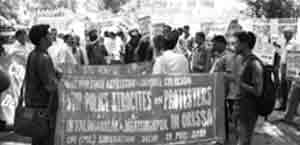COMMENTARY
Orissa :
New Chapter of State Brutality on People’s Movements
Tapas Ranjan Saha
In Orissa today, police have a free hand to shoot and corporations a free hand to loot. Naveen Patnaik, from behind his charade of ‘peaceful indusrialisation’, has emerged as one of the most trigger-happy lieutenants to displace and evict the tribals, peasants and fisherfolks so that mineral-rich land of the state can be up for corporate loot. Under the diktats of imperialist funding agencies like DFID and UNIDO, all the laws of land (like the Forest Rights Act ), all environmental concerns and all norms of democratic dialogue regarding rehabilitation are being flouted by the Orissa government to expedite the corporate land-grab at gunpoint.
The Congress and the BJP have, in the wake of protests against the spate of police firing, ‘criticised’ the BJD State Government. Their hypocrisy is exposed by the fact that the BJP till last year was an alliance partner of the same BJD-led Government; and Manmohan Singh and Sonia Gandhi have, on Republic Day this year, expressed commitment to their special guest, the South Korean President, towards expediting the POSCO venture in Orissa.
Fresh Offensive in Kalinganagar 
For almost five years now people of Kalinganagar are engaged in a protracted struggle against the takeover of their land by a Tata Steel plant in the area. The massive police firing on protesting tribals on 2 Jan 2006 that led to the killing of 14 tribals was a turning point. In recent months Orissa government has started a virtual war with targeted armed attacks on the villages of Chandia, Baligota, Chama Kutli, Gobarghati, Garhpur, Belhari and Ambagaria in Kalinganagar to facilitate the construction of a ‘common corridor’ that will provide a ‘safe passage’ from main road to Tata’s proposed project site without any ‘obstruction’ from local villagers.
On 30th March 2010, an organised gang of Tata goons and Orissa State Police comprising 29 platoons of armed police forces, two platoons of NSG commandoes and 70 top police officers launched a massive attack on the village Baligota. Around 40 villagers including six women got gunshot injuries even while the houses of the leading protesters of the Bisthapan Birodhi Mancha along with foodgrains were set on fire. On May 12 once again when the police opened fire during another demolition drive in the Chandia village Laxman Jamunda, a 65-year-old tribal, fell to a police bullet while two women have been seriously injured. In further sordid moves, police tried to hush up the cold blooded murder by secretly disposing of Laxman’s body, terrorizing his nephew and planting false news stories. The demolition and repression drive continues.
Jagatsinghpur Firing: Paving the Way for POSCO
Like Kalingnagar, the anti-POSCO movement at Jagatsingpur too has emerged as a powerful symbol of broad mass resistance against forced acquisition of land in the name of ‘development’.
By touting a 12-million-tonne steel plant at an investment of Rs 55,200 crore by Pohang Iron and Steel Company (POSCO) near the port town of Paradip as the largest FDI ever in India, UPA at the Centre and the local BJD government have been working overtime for last five years to bend all laws and rules to give the South Korean steel giant control over more than 6000 acres of land for the plant project and immediate control over 600 million tonnes of iron ore (with prospects for another 400 million tones later). While POSCO’s own estimate promises no more than 13,000 jobs, the project is bound to displace around 40,000 people in the plant and port sites alone (not to mention the massive displacement in the mine areas) and snatch away the livelihood of around 20,000 people engaged in profitable cultivation and fishing in the proposed plant site alone. While Brazil and China rejected POSCO’s dubious proposals and demands, governments in India have bent over backwards to mortgage huge tracts of land, iron ore and water resources to this MNC for a pittance, extended massive tax holidays through SEZ provisions while displacing and devastating its own people inhabiting and earning a gainful livelihood in the area.
Local people organized by several left parties and other groups have sustained a brave resistance in the face of arrests of leaders, police brutalities and repeated attempts by the government and corporate mercenaries to break the resistance by buying over a section of local people in favour of POSCO. Foiling the machinations, the anti-POSCO movement succeeded in stalling the project. Since, January this year, following the combined assurance by the UPA and BJD governments to the South Korean President to expedite the project, the anti-POSCO movement gathered fresh momentum and a massive peaceful dharna at Balitutha has been going on since midnight on 26 January 2010. On 15 May it was at this Dharna site that the massive attack by 25 platoons of the Orissa police was launched. More than 100 people, including women and children, are reportedly injured, five of them seriously. Those (including the local MP from CPI) attempting to visit the area in solidarity with the protesters are being arrested. Yet people in Orissa continue to intensify their protests. On 20th May a statewide protest day was observed in Orissa by CPI(ML). Delhi State committee of the party also organised a protest demonstration at Orissa Bhawan on 19th May in the national caital.
Atrocities on 15 May in Balitutha:
Excerpts from a Citizen Journalist’s Report
(Below are excerpts from a report circulated on the internet by a citizen journalist who managed to visit the site soon after the firing.)
Three days after the 15th May assault by police forces on the peaceful assembly of villagers in Balitutha, nearly every household in the villages of Dhinkia, Gobindapur and Nuagaon have people who are injured and traumatized. Since 15 May, all exit points from the villages have been sealed and anyone stepping out threatened with arrest, and as a result nearly no one has received medical treatment for their wounds.
At Balitutha, police vengefully not only burnt down the shamiana under which the dharna was being held for the past five months, but also set fire to all the roadside shops, eateries and thatched houses on one side of the Balitutha bridge.
There are around two hundred injured people in the three villages. Wounds are from rubber bullets, lathis and, something that I had seen for the first time, from pellets fired from shotguns. These are small spherical pellets, like bicycle ball-bearings, which have been fired in thousands. Many people have five or six of these painfully embedded under their skins. This is a most inhuman weapon, which have been used in the past in Israel and South Africa to break up demonstrations without causing life-threatening injuries. The Orissa police seem to have adopted this as a new means of sowing terror among peaceful demonstrators. Without availability of doctors and unable to reach hospitals, many people are being forced to extract the pellets at home using knifes and blades.
Women seem to have been especially targeted for assault and humiliation. Most of the wounded we saw were women. Mounabati Das, in her fifties, who after being hit by a rubber bullet on her leg and falling on the ground, described how she was dragged around by her hair by the police who threatened her in filthy language that this would be the consequence of resisting the government. She has a large subcutaneous blood clot from the rubber bullet which hit her thigh and walks around with great difficulty. Tikki Bardhan, whose foot seems to have been fractured after being hit by a rubber bullet, cannot even walk. Her husband, Bharat Bardhan, was hit by a rubber bullet and a shotgun pellet on his face. Shantilata Mahapatra was hit by a rubber bullet and a shotgun pellet on her leg. I extracted the pellet with difficulty from her leg and dressed up the wound and gave her a course of antibiotics which I had taken with me.
Gujuri Mahanti, a 72 year old grandmother, has been hit by three rubber bullets on the back of her head, on the small of her back and behind her waist. She said the police ordered women to leave the dharna spot in front of the bridge. When the women moved away, police attacked with tear gas, rubber bullets and pellet guns, and kept firing on their backs as they tried to run away. This is clearly shown by the fact that she was hit by rubber bullets on her back. The police, who had the advantage of being situated on higher round on the bridge, fired at will on the people assembled on lower ground at one end of the bridge. When the women were running away, the police descended from the bridge and assaulted them with lathis and dragged them around by their hair. Five of them, including a 60 year old grandmother, were dragged into police vans and taken away. Their relatives do not know till now what has been their fate.
These stories were repeated in every home. The people are now awaiting an imminent attack on the villages itself which the administration has already threatened. However, they say that these wounds have only strengthened their resolve to resist, and there will be a blood bath if the police enter their villages. But 72 year old Gujuri Mahanti had a question addressed to Naveen Patnaik, “Would he treat his mother in the same way that the police had treated her?” As Naveen Patnaik, with his masters at TATA, POSCO, tries to bring “development” to Orissa with rubber bullets and shotgun pellets, this is the question that confronts him from poor village women who are resolved to resist this aggression on their lives and livelihoods.
|


